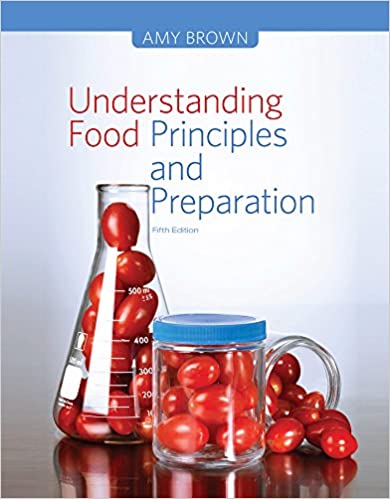
Understanding Food 5th Edition by Amy Christine Brown
Edition 5ISBN: 978-1133607151
Understanding Food 5th Edition by Amy Christine Brown
Edition 5ISBN: 978-1133607151 Exercise 1
List the five taste stimuli and the proposed mechanism of taste for each.
Explanation
The taste of the food can be experienced by the taste buds on the tongue. The food dissolved in the saliva of mouth is in contact with gustatory cells that send a message to the brain through cranial nerves. The electrical impulse generated by the nerves gives the sensation of taste.
There are five types of taste stimuli. They are sweet, sour, biter, salty and savory or umami. The savory taste is found in some amino acids. The sweet and sour tastes are experienced by tip of the tongue. The salty taste is sensed by sides of the tongue and the bitter taste by the back of the tongue.
The sugar taste of the food is due to the chemical structure of molecules present in the food such as aldehydes, glycols, alcohols etc.. The mechanism of sweet taste and its receptor is not well known.
The sour taste corresponds to the presence of acids in the food and the hydrogen ion (H + ) concentration. The acids are found in many fruits, vinegar and few vegetables.
Bitterness is found in beverages like tea, coffee, chocolate (theobromine) and grape fruits containing phenolic compounds. Bitterness can act as alarming system to avoid the consumption of toxic and poisonous compounds. Several compounds of plant origin like alkaloids are bitter to taste.
Salt taste of foods is due to presence of sodium (Na + ) or sodium chloride (NaCl). The sides of the tongue experience the salty taste of the foods.
Umami or savory taste of the foods is due to presence of certain amino acids like Glutamate. Some individuals can detect the monosodium glutamate (MSG) in foods due to its savory taste produced by glutamate.
There are five types of taste stimuli. They are sweet, sour, biter, salty and savory or umami. The savory taste is found in some amino acids. The sweet and sour tastes are experienced by tip of the tongue. The salty taste is sensed by sides of the tongue and the bitter taste by the back of the tongue.
The sugar taste of the food is due to the chemical structure of molecules present in the food such as aldehydes, glycols, alcohols etc.. The mechanism of sweet taste and its receptor is not well known.
The sour taste corresponds to the presence of acids in the food and the hydrogen ion (H + ) concentration. The acids are found in many fruits, vinegar and few vegetables.
Bitterness is found in beverages like tea, coffee, chocolate (theobromine) and grape fruits containing phenolic compounds. Bitterness can act as alarming system to avoid the consumption of toxic and poisonous compounds. Several compounds of plant origin like alkaloids are bitter to taste.
Salt taste of foods is due to presence of sodium (Na + ) or sodium chloride (NaCl). The sides of the tongue experience the salty taste of the foods.
Umami or savory taste of the foods is due to presence of certain amino acids like Glutamate. Some individuals can detect the monosodium glutamate (MSG) in foods due to its savory taste produced by glutamate.
Understanding Food 5th Edition by Amy Christine Brown
Why don’t you like this exercise?
Other Minimum 8 character and maximum 255 character
Character 255


